When collaboration really counts: Demolishing Denmark’s fire-ravaged Old Stock Exchange
27 November 2024
On April 16, 2024, a devastating fire broke out at The Old Stock Exchange Børsen, a landmark and protected 17th-century building in central Copenhagen undergoing renovation.
As flames consumed large portions of the structure, the collapse of scaffolding further jeopardised the building’s historic integrity. The crisis demanded an extraordinary response to protect what remained of this cultural treasure.
Demonstrating the power of collaboration, four competing demolition companies united to stabilise the site, retrieve historical elements, and safeguard the possibility of a faithful reconstruction.
 The Old Stock Exchange before the fire. (PHOTO: P. Olesen)
The Old Stock Exchange before the fire. (PHOTO: P. Olesen)
Background and Context
Børsen, a renowned architectural symbol of Denmark’s architectural heritage, was in the middle of a copper roof renovation when the fire ignited.
The structure was encased in scaffolding covered by plastic netting, which facilitated the fire’s rapid spread and obstructed firefighting efforts. The heat caused sections of the roof and scaffolding to collapse, pulling down portions of the structure’s outer walls and leaving other parts precariously unstable.
 Smoke from the fire could be seen from across Copenhagen. (PHOTO: P. Olesen)
Smoke from the fire could be seen from across Copenhagen. (PHOTO: P. Olesen)
Despite days of firefighting, the blaze remained uncontrollable, leading to partial structural collapses. The remaining walls were at risk of falling, complicating plans to reconstruct the building authentically.
Scope of Work
Celero Denmark, part of the Jensen Group, assembled a team of Denmark’s top demolition firms—including sister company J. Jensen Demolition and competitors Tscherning, P. Olesen, and Hockerup—to help mitigate the damage and preserve the structure.
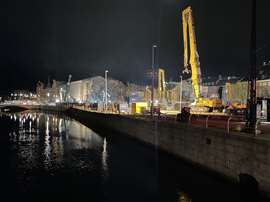 (PHOTO: P. Olesen)
(PHOTO: P. Olesen)
Their primary tasks included dismantling the scaffolding, clearing debris, stabilising remaining walls, and salvaging valuable historic elements from the wreckage.
The combined efforts of these competitors created an unprecedented collaboration, united by a shared commitment to protecting Denmark’s heritage.
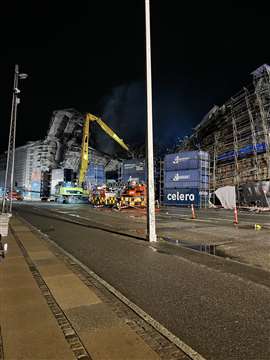 J. Jensen Demolition was the first demolition contractor to arrive onsite. (PHOTO: P. Olesen)
J. Jensen Demolition was the first demolition contractor to arrive onsite. (PHOTO: P. Olesen)
Key Challenges
The intertwined scaffolding, which had collapsed on 18 April and become a structural hazard, presented a complex challenge for the team.
As the roof scaffolding was connected to the side scaffolding and a row of containers, the entire scaffolding structure twisted, placing great weight on the structure’s outer walls and putting them in immediate risk of failure.
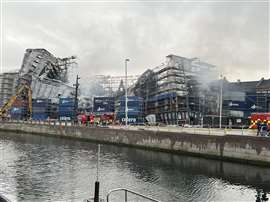 Days after the fire started, the emergency services were still on scene. (PHOTO: P.Olesen & Sonner)
Days after the fire started, the emergency services were still on scene. (PHOTO: P.Olesen & Sonner)
Removing the scaffolding required careful dismantling, by all the project contractors, to prevent further damage.
Additionally, the teams worked through many nights, under tight time constraints and the ever-present threat of further structural collapses.
The logistical hurdles of operating in a bustling city centre added another layer of complexity.
Logistics and Machinery
Critical equipment such as Tscherning’s 80-tonne Liebherr 950 demolition machine—which had an extra-long boom/arm, a 28-m reach—and a Liebherr 980 from P. Olesen had to be swiftly transported to the site under police escort.
Tscherning’s 950 demolition machine made it to the Børsen site just hours after the company was called into action on 19 April. The machine was joined by P. Olesen’s Liebherr 980 later that night, after it had been transported in seven pieces on seven flatbed trucks to the scene. It was reassembled onsite with mobile cranes, and joined operations before midnight.
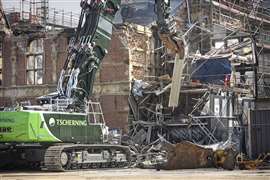 Tscherning’s Liebherr excavator was onsite within hours of the company being deployed. (PHOTO: P. Olesen)
Tscherning’s Liebherr excavator was onsite within hours of the company being deployed. (PHOTO: P. Olesen)
Once operational, the machines played a vital role in separating roof scaffolding from side scaffolding and clearing debris. A scrap grab attachment was used for dismantling, while a grain shovel helped remove fallen materials, enabling emergency services to access the interior.
Collaboration and Coordination
Daily planning meetings were utilised to ensure both safety and that each company’s resources were optimally put to use.
Despite being industry competitors, P. Olesen, J. Jensen, Tscherning, and Hockerup worked together effectively, pooling resources and expertise. Machine operators from different firms assisted one another, fostering a unified effort throughout the six-week operation.
Operator Jan René Andersen from Tscherning reflected on the experience: “We had a significant common task to solve, and for a while, we were a united strong team, not competitors as we normally are in everyday life.”
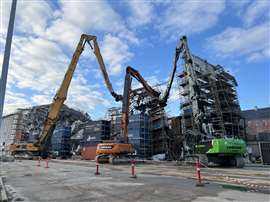 The giant excavators of P. Olesen (yellow), Hockerup (orange) and Tscherning (green) worked together to untangle and remove the damaged scaffolding. (PHOTO: P. Olesen)
The giant excavators of P. Olesen (yellow), Hockerup (orange) and Tscherning (green) worked together to untangle and remove the damaged scaffolding. (PHOTO: P. Olesen)
Preservation Efforts
Salvaging historical elements was also a top priority. The demolition teams meticulously retrieved fallen ornaments, statues, and architectural features.
Additionally, debris was transported to a secure location where it was inspected collaboratively with police, cultural authorities and emergency services to identify and recover culturally significant remnants.
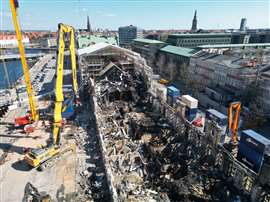 Once the scaffolding had been removed, the full extent of damage was clear. (PHOTO: P. Olesen)
Once the scaffolding had been removed, the full extent of damage was clear. (PHOTO: P. Olesen)
Outcomes
Through round-the-clock work, the demolition companies stabilised the structure and salvaged substantial elements of Børsen’s heritage.
Over six weeks, the team successfully cleared the site, making it safe for reconstruction efforts while preserving key aspects of the original design.
 (PHOTO: P. Olesen)
(PHOTO: P. Olesen)
Client and Operator Reflections
A representative from Celero Denmark described the project as a turning point for the industry: “The rescue of the burned Børsen is a symbol that collaboration across the industry can move mountains. We made the impossible possible because we stood together.”
Olesen’s machine operator, Martin Blaabjerg, echoed this sentiment, stating that the site’s atmosphere of mutual support and professionalism made the challenging work both effective and rewarding.
The emergency operation at Børsen highlights the effectiveness of collaboration in the demolition industry during crises. By uniting resources, expertise, and efforts, the team achieved the dual goals of safeguarding cultural heritage and preparing the site for future reconstruction.
CONNECT WITH THE TEAM





